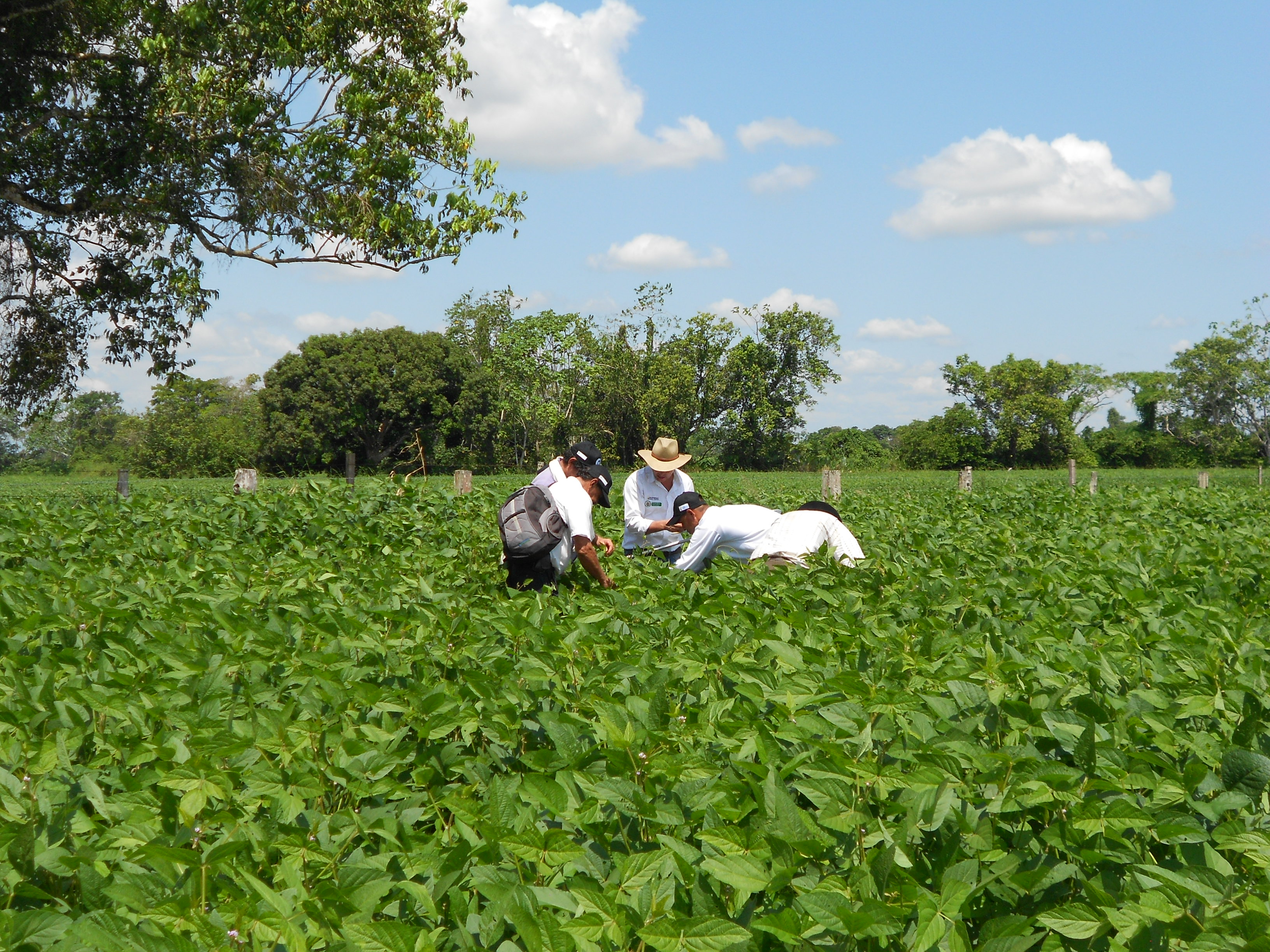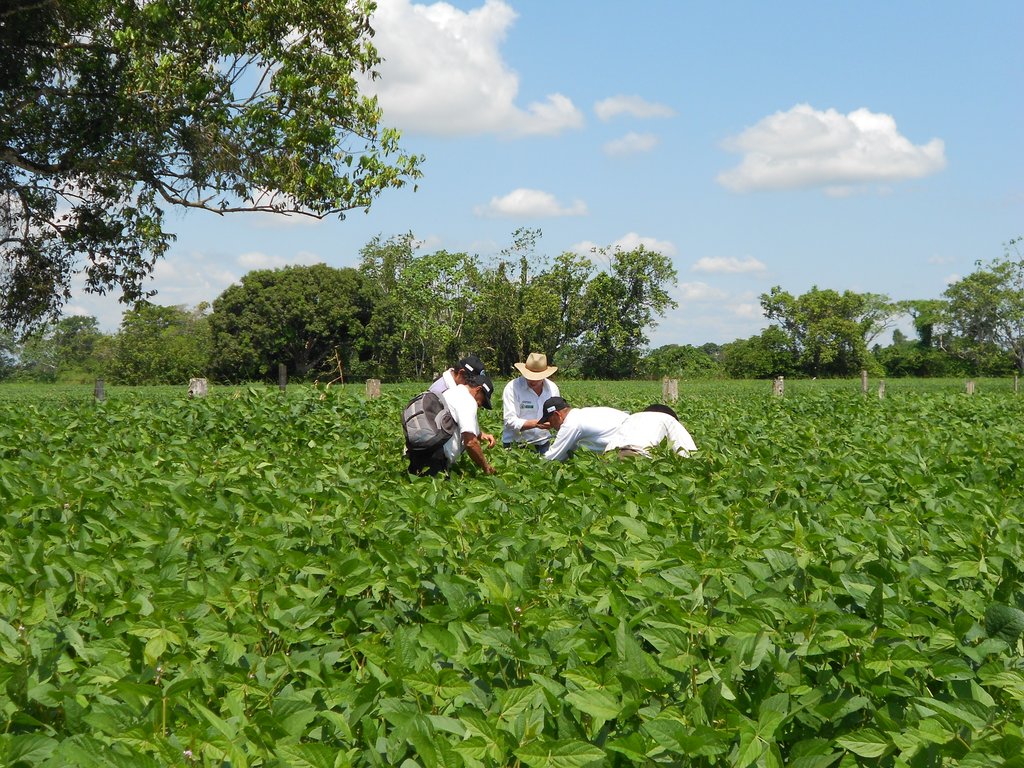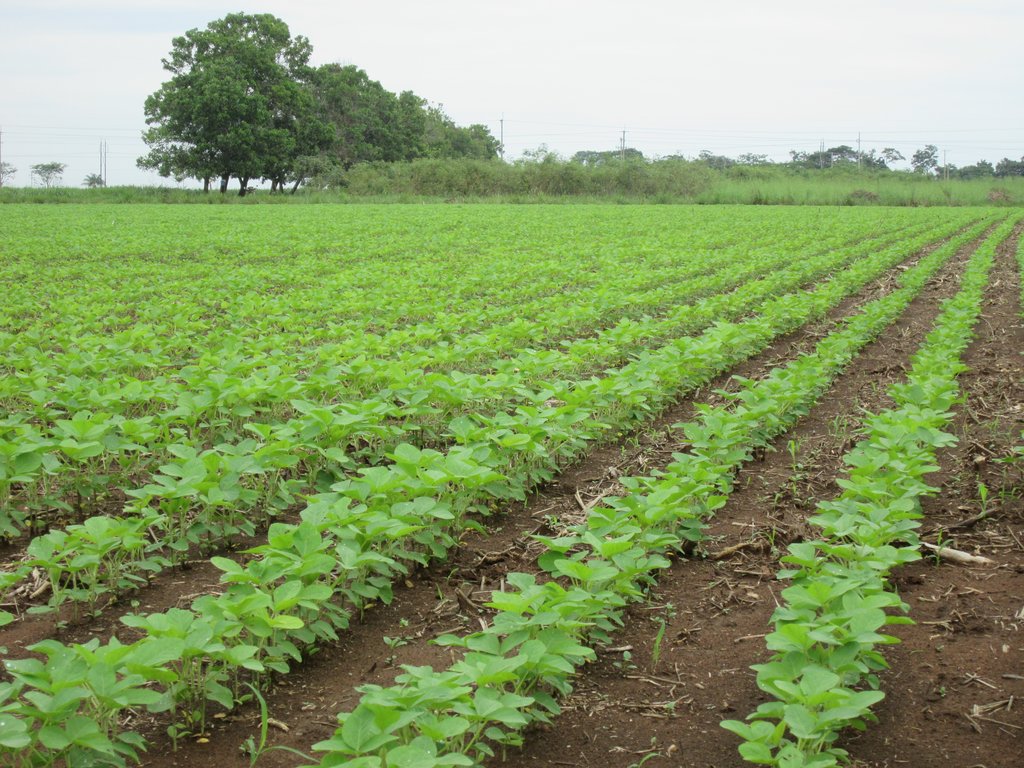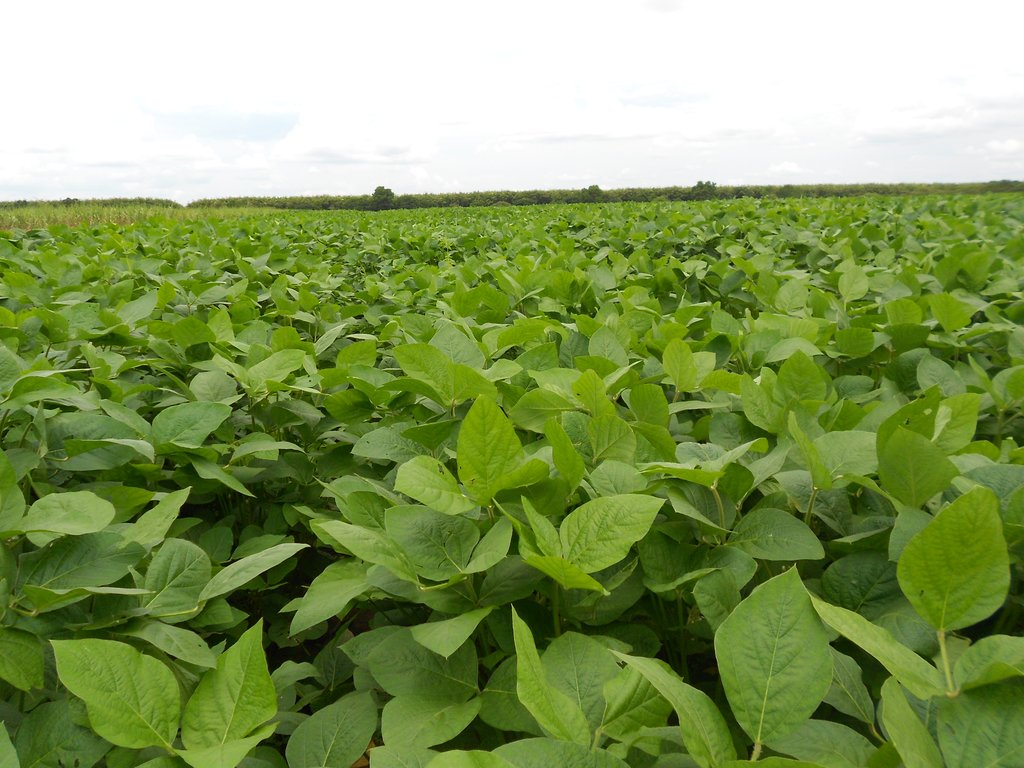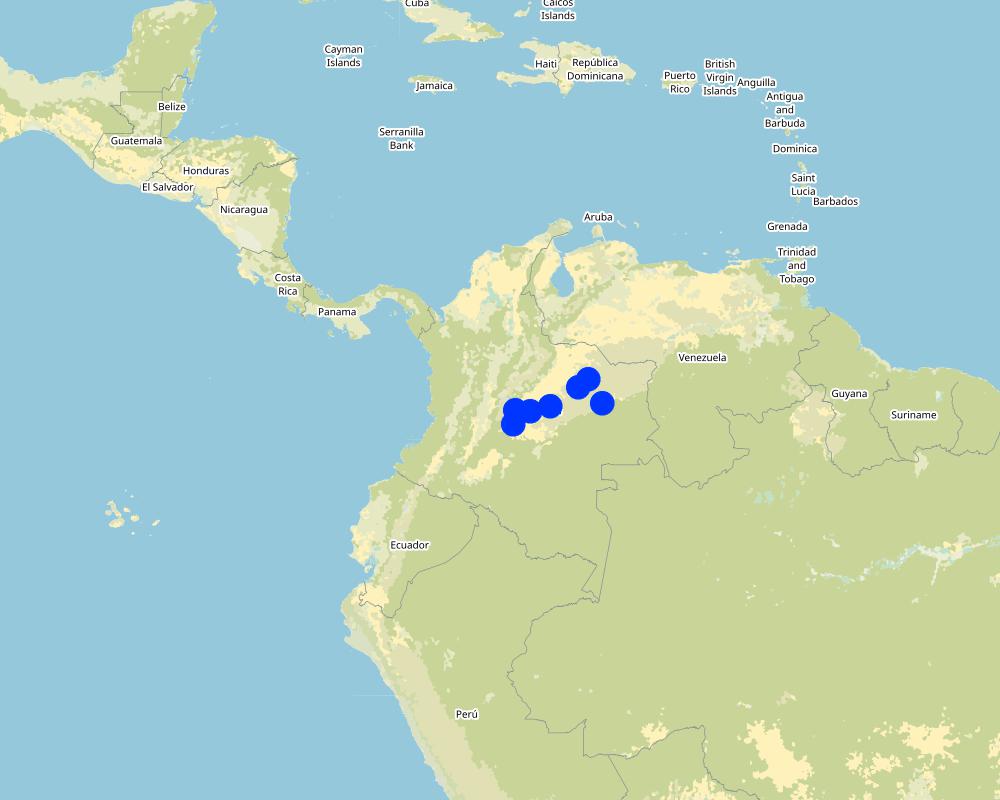A Soybean variety with high protein content and disease tolerance [Colombia]
- Creation:
- Update:
- Compiler: Claudia Patricia Rendón Ocampo
- Editor: –
- Reviewer: Mateo Jaimes
Soya Guayuriba 9
technologies_5874 - Colombia
View sections
Expand all Collapse all1. General information
1.2 Contact details of resource persons and institutions involved in the assessment and documentation of the Technology
SLM specialist:
Tibocha Ardila Yuli Sthephani
Corporación colombiana de investigación agropecuaria- AGROSAVIA
Colombia
1.3 Conditions regarding the use of data documented through WOCAT
The compiler and key resource person(s) accept the conditions regarding the use of data documented through WOCAT:
Yes
1.4 Declaration on sustainability of the described Technology
Is the Technology described here problematic with regard to land degradation, so that it cannot be declared a sustainable land management technology?
No
2. Description of the SLM Technology
2.1 Short description of the Technology
Definition of the Technology:
A higher yielding variety of soybean (Glycine max var. Corpoica Guayuriba 9) was developed to help meet the demand for soya in Colombia. Additionally, it has a high protein content and tolerance to limiting diseases and to root rot. As with all legumes it fixes nitrogen in the soil and can be a valued component of crop rotations.
2.2 Detailed description of the Technology
Description:
Currently, there is a growing demand for soya in Colombia (approx. 1,900,000 tonnes per year currently). Only 7% is produced domestically. However, in the Colombian Orinoquia there is a potential area of 500,000 hectares which could help meet this demand.
The Corpoica Guayuriba 9 variety was developed at the La Libertad research center as a genetic alternative for soybean cultivation in the Colombian Orinoquia region. It is an intermediate cycle material with 105 days to harvest, determinate growth habits, white flowers, and cream-colored seeds. Its potential grain yield is up to 3.0 t/ha. This variety offers comparative advantages such as a higher number of pods per plant (45), seed weight of 15 g, high oil protein content, and tolerance to leaf diseases and other viral complexes.
Corpoica Guayuriba 9 is an economically viable and environmentally sustainable alternative, due to its excellent association with bacteria of the Bradyrhizobium genus for symbiotic nitrogen fixation, contributing to the improvement of the rotation system with cereals, such as rice-soybean-corn-soybean, helping build up nutrients in the soil. This allows rationalization in the use of nitrogen fertilizers in each crop cycle, reduces production costs, and increases yields.
In addition, it is a very important source of raw material for the production of balanced feed because of its high content of protein, amino acids, and essential fatty acids for the production of animal concentrates and human food with high protein values.
2.3 Photos of the Technology
2.5 Country/ region/ locations where the Technology has been applied and which are covered by this assessment
Country:
Colombia
Region/ State/ Province:
Meta
Further specification of location:
Villavicencio, Granada, Puerto López y Puerto Gaitan, San Martín, Primavera, Santa Rosalía y Cumaribo
Specify the spread of the Technology:
- applied at specific points/ concentrated on a small area
Is/are the technology site(s) located in a permanently protected area?
No
Map
×2.6 Date of implementation
Indicate year of implementation:
2017
If precise year is not known, indicate approximate date:
- less than 10 years ago (recently)
2.7 Introduction of the Technology
Specify how the Technology was introduced:
- during experiments/ research
Comments (type of project, etc.):
La variedad Corpoica Guayuriba 9 se obtuvo a partir del cruzamiento de la línea 2130 x Suprema, que dio origen a la línea L-189. Esta línea fue evaluada en un primer ciclo en Ensayos Preliminares de Rendimiento (EPR), en sus componentes de rendimiento, comportamiento sanitario, reacción a plagas; luego se sometió a Ensayos de Rendimiento multiambientes (ERM) para determinar sus nivel de estabilidad y finalmente en Pruebas de Evaluación Agronómicas (PEAs) y pruebas Semicomerciales reglamentadas por el (ICA, 2020), fue seleccionada por sus atributos de identidad, homogeneidad y estabilidad. Fue inscrita como Copoica Guayuriba 9 en el registro de nuevos cultivares del ICA.
3. Classification of the SLM Technology
3.1 Main purpose(s) of the Technology
- improve production
- reduce, prevent, restore land degradation
- preserve/ improve biodiversity
3.2 Current land use type(s) where the Technology is applied
Land use mixed within the same land unit:
No

Cropland
- Annual cropping
Annual cropping - Specify crops:
- legumes and pulses - soya
Number of growing seasons per year:
- 1
Is intercropping practiced?
No
Is crop rotation practiced?
Yes
If yes, specify:
arroz-soya-maíz-soya
3.3 Has land use changed due to the implementation of the Technology?
Has land use changed due to the implementation of the Technology?
- No (Continue with question 3.4)
3.4 Water supply
Water supply for the land on which the Technology is applied:
- mixed rainfed-irrigated
3.5 SLM group to which the Technology belongs
- rotational systems (crop rotation, fallows, shifting cultivation)
- improved plant varieties/ animal breeds
3.6 SLM measures comprising the Technology

agronomic measures
- A1: Vegetation/ soil cover
- A2: Organic matter/ soil fertility
- A5: Seed management, improved varieties
3.7 Main types of land degradation addressed by the Technology

chemical soil deterioration
- Cn: fertility decline and reduced organic matter content (not caused by erosion)
3.8 Prevention, reduction, or restoration of land degradation
Specify the goal of the Technology with regard to land degradation:
- reduce land degradation
- restore/ rehabilitate severely degraded land
4. Technical specifications, implementation activities, inputs, and costs
4.1 Technical drawing of the Technology
Technical specifications (related to technical drawing):
Corpoica Guayuriba 9 presenta rendimientos de 3.0 t/ha supera los rendimientos promedios de soya en la Altillanura (2.6 t/ha) y del Piedemonte llanero (2.2 t/ha), alta cantidad de vainas por planta (45), uniformidad de secado a cosecha.
De ciclo intermedio, se cosecha a los 104 días, y es una excelente alternativa en los sistemas de rotación arroz-soya, maíz-soya lo que rompe el esquema del monocultivo, permite mejorar la fertilidad del suelo y facilita el manejo de malezas, plagas y enfermedades.
La capacidad para establecer asociación simbiótica con bacterias que fijan el nitrógeno atmosférico, permite suplir los requerimientos de nitrógeno del cultivo, reducir los impactos ambientales negativos de la fertilización nitrogenada y los costos de producción.
4.2 General information regarding the calculation of inputs and costs
Specify how costs and inputs were calculated:
- per Technology area
Indicate size and area unit:
1 hectárea
other/ national currency (specify):
COP
If relevant, indicate exchange rate from USD to local currency (e.g. 1 USD = 79.9 Brazilian Real): 1 USD =:
4048.67
4.3 Establishment activities
| Activity | Timing (season) | |
|---|---|---|
| 1. | Análisis de suelo- suelos mejorados | 1 mes antes del establecimiento |
| 2. | Alistamiento del terreno (desbroza y quema química para control de maleza) | 20 días |
| 3. | Inoculación de la semilla y siembra con máquina | Antes de inicio de lluvias en el primer y segundo semestre |
| 4. | Control de malezas (pre-emergentes y pos-emergentes) | Durante establecimiento de cultivo |
| 5. | Manejo agronómico según indicaciones de monitoreo y seguimiento | Durante establecimiento de cultivo |
| 6. | Cosecha | 1 día |
| 7. | Beneficio de la semilla (secado, limpieza y clasificación) | 1 semana |
4.4 Costs and inputs needed for establishment
| Specify input | Unit | Quantity | Costs per Unit | Total costs per input | % of costs borne by land users | |
|---|---|---|---|---|---|---|
| Labour | Mano de obra siembra | Jornal | 1.0 | 104253.0 | 104253.0 | 1.94 |
| Labour | Mano de obra fertilización | Jornal | 1.0 | 104253.0 | 104253.0 | 1.94 |
| Labour | Mano de obra control de enfermedades | Jornal | 1.0 | 104253.0 | 104253.0 | 1.94 |
| Labour | Mano de obra cosecha | Jornal | 1.0 | 104253.0 | 104253.0 | 1.94 |
| Equipment | Preparación terreno- Rastra | Pase/tractor | 1.0 | 80000.0 | 80000.0 | 1.49 |
| Equipment | Preparación terreno- Cincel | Pase/Tractor | 1.0 | 80000.0 | 80000.0 | 1.49 |
| Equipment | Preparación terreno- Pulida | Pase/Tractor | 1.0 | 70000.0 | 70000.0 | 1.31 |
| Equipment | Servicio de máquina corta a granel | Kilo | 3000.0 | 180.0 | 540000.0 | 10.07 |
| Equipment | Aplicación 1ra abonada | Pase/Tractor | 1.0 | 70000.0 | 70000.0 | 1.31 |
| Equipment | Aplicación Pre-emergencia | Pase/Tractor | 1.0 | 70000.0 | 70000.0 | 1.31 |
| Equipment | Aplicación control de enfermedades | Pase/Tractor | 4.0 | 70000.0 | 280000.0 | 5.22 |
| Plant material | Semilla | Kilo | 80.0 | 7000.0 | 560000.0 | 10.44 |
| Plant material | Siembra- enmienda-fertilización | Ha | 1.0 | 60000.0 | 60000.0 | 1.12 |
| Plant material | Rhizobiol (tto de semilla) | Litro | 0.8 | 15000.0 | 12000.0 | 0.22 |
| Plant material | Enmiendas y correctivos | Toneladas | 2.0 | 46000.0 | 92000.0 | 1.72 |
| Fertilizers and biocides | Sulcamag | Bulto/50 Kilos | 2.0 | 55000.0 | 110000.0 | 2.05 |
| Fertilizers and biocides | Cloruro de potasio (KLC) | Bulto/ 50 Kilos | 3.0 | 160000.0 | 480000.0 | 8.95 |
| Fertilizers and biocides | Granufos | Bulto/50 Kilos | 3.0 | 103000.0 | 309000.0 | 5.76 |
| Fertilizers and biocides | Kieserita | Bulto/50 Kilos | 1.5 | 155000.0 | 232500.0 | 4.34 |
| Fertilizers and biocides | Fosfato diamónico (DAP 18-46-00) | Bulto/50 Kilos | 1.0 | 180000.0 | 180000.0 | 3.36 |
| Fertilizers and biocides | Boronzinco | Bulto/50 Kilos | 1.0 | 88000.0 | 88000.0 | 1.64 |
| Fertilizers and biocides | Urea | Bulto/50 Kilos | 1.0 | 160000.0 | 160000.0 | 2.98 |
| Fertilizers and biocides | Dual Gold | Litro | 2.0 | 98000.0 | 196000.0 | 3.66 |
| Construction material | Gramoxone | Litro | 1.0 | 195000.0 | 195000.0 | 3.64 |
| Construction material | Sencor | Litro | 0.5 | 145000.0 | 72500.0 | 1.35 |
| Construction material | Metarhizium | Bolsa | 0.4 | 66625.0 | 26650.0 | 0.5 |
| Construction material | Sevín | Libra | 1.5 | 36000.0 | 54000.0 | 1.01 |
| Construction material | Match | Litro | 0.3 | 140506.0 | 42151.8 | 0.79 |
| Construction material | Cipermetrina | CC | 150.0 | 37.0 | 5550.0 | 0.1 |
| Construction material | Carbendazim | Litro | 1.0 | 25000.0 | 25000.0 | 0.47 |
| Construction material | Nativo | Litro | 0.5 | 135000.0 | 67500.0 | 1.26 |
| Other | Select | Litro | 1.0 | 130000.0 | 130000.0 | 2.42 |
| Other | Flex | Litro | 1.0 | 189000.0 | 189000.0 | 3.52 |
| Other | Imidacropid | Litro | 1.0 | 56000.0 | 56000.0 | 1.04 |
| Other | Amistar top | Litro | 0.5 | 271000.0 | 135500.0 | 2.53 |
| Other | Amistra Zetra | Litro | 0.5 | 313000.0 | 156500.0 | 2.92 |
| Other | Transporte cosecha | Kilo | 3000.0 | 40.0 | 120000.0 | 2.24 |
| Total costs for establishment of the Technology | 5361863.8 | |||||
| Total costs for establishment of the Technology in USD | 1324.35 | |||||
If you are unable to break down the costs in the table above, give an estimation of the total costs of establishing the Technology:
2820625.0
Comments:
Los costos de establecimiento son con base en los precios que se utilizan en los Centros de investigación (el pago incluye las prestaciones reglamentarias por ley) y son referentes del año 2.021. El jornal se estima en pesos colombiano y equivale al trabajo agropecuario realizado durante 8 horas.
4.5 Maintenance/ recurrent activities
| Activity | Timing/ frequency | |
|---|---|---|
| 1. | Rotación con gramíneas- cobertura (millo, sorgo) | Después de la cosecha y antes de nueva siembra de soya |
| 2. | Inocular la smeilla | Antes de siembra |
4.6 Costs and inputs needed for maintenance/ recurrent activities (per year)
Comments:
No se realiza mantenimiento dado que es un cultivo semestral.
4.7 Most important factors affecting the costs
Describe the most determinate factors affecting the costs:
Entre los factores que más afectan los costos se presentan:
Factores bióticos (enfermedades: roya -Phakopsora sp.)
Factores abióticos (ambiental: estrés hídrico).
5. Natural and human environment
5.1 Climate
Annual rainfall
- < 250 mm
- 251-500 mm
- 501-750 mm
- 751-1,000 mm
- 1,001-1,500 mm
- 1,501-2,000 mm
- 2,001-3,000 mm
- 3,001-4,000 mm
- > 4,000 mm
Indicate the name of the reference meteorological station considered:
Estaciones meteorológicas (Tipo Davis): Aliar-Fazenda, Taparitas.
Agro-climatic zone
- sub-humid
Las lluvias son variables en intensidad.
5.2 Topography
Slopes on average:
- flat (0-2%)
- gentle (3-5%)
- moderate (6-10%)
- rolling (11-15%)
- hilly (16-30%)
- steep (31-60%)
- very steep (>60%)
Landforms:
- plateau/plains
- ridges
- mountain slopes
- hill slopes
- footslopes
- valley floors
Altitudinal zone:
- 0-100 m a.s.l.
- 101-500 m a.s.l.
- 501-1,000 m a.s.l.
- 1,001-1,500 m a.s.l.
- 1,501-2,000 m a.s.l.
- 2,001-2,500 m a.s.l.
- 2,501-3,000 m a.s.l.
- 3,001-4,000 m a.s.l.
- > 4,000 m a.s.l.
Indicate if the Technology is specifically applied in:
- not relevant
5.3 Soils
Soil depth on average:
- very shallow (0-20 cm)
- shallow (21-50 cm)
- moderately deep (51-80 cm)
- deep (81-120 cm)
- very deep (> 120 cm)
Soil texture (topsoil):
- medium (loamy, silty)
- fine/ heavy (clay)
Soil texture (> 20 cm below surface):
- fine/ heavy (clay)
Topsoil organic matter:
- medium (1-3%)
If available, attach full soil description or specify the available information, e.g. soil type, soil PH/ acidity, Cation Exchange Capacity, nitrogen, salinity etc.
Los suelos de la Altillanura se caracterizan por tener pH ácidos (4.0 a 5.2), bajos contenidos de : P, Ca, Mg, K, S, M.O y alta saturación de aluminio (>60%).
Por su excelente asociación con bacterias del género Bradyrhizobium para la fijación simbiótica del nitrógeno contribuyen con el mejoramiento del sistema de rotación con gramíneas (Arroz-Maíz) en ciclos semestrales o anuales.
5.4 Water availability and quality
Ground water table:
on surface
Availability of surface water:
poor/ none
Comments and further specifications on water quality and quantity:
El régimen de lluvias en monomodal de abril a diciembre con una precipitación promedio anual de 1.800 a 2.500 mm. Entre enero a marzo se presenta un periodo de intensa sequía mientras que el período lluvioso es intermitente con periodos cortos de estrés hídrico. El estrés hídrico (déficit hídrico > 4 días durante el desarrollo del cultivo) es uno de los factores abióticos más limitantes.
5.5 Biodiversity
Species diversity:
- medium
Habitat diversity:
- medium
5.6 Characteristics of land users applying the Technology
Sedentary or nomadic:
- Sedentary
Market orientation of production system:
- commercial/ market
Relative level of wealth:
- average
Individuals or groups:
- individual/ household
Level of mechanization:
- mechanized/ motorized
Gender:
- men
Age of land users:
- middle-aged
5.9 Access to services and infrastructure
roads and transport:
- poor
- moderate
- good
Sistema de almacenamiento:
- poor
- moderate
- good
Comments:
Vías de acceso, molinos, sistemas de almacenamiento.
6. Impacts and concluding statements
6.1 On-site impacts the Technology has shown
Socio-economic impacts
Production
crop production
Quantity before SLM:
2,5 t ha-1
Quantity after SLM:
2,6 a 3 Ton/ha
Comments/ specify:
Contribuye al aumento significativo de la producción de grano
Ecological impacts
Soil
nutrient cycling/ recharge
Comments/ specify:
con el uso del inoculante líquido elaborado con base en la mezcla de las cepas ICA J01 e ICA J96 en el establecimiento del cultivo de la variedad, Guayuriba 9 reduce la aplicación de nitrógeno en un 50 % y 80 %, reemplazando este nutriente en niveles superiores a 150 kg/ha.
Specify assessment of on-site impacts (measurements):
Esta variedad presenta ciclos de 104 a 108 días, las variedades comerciales de soya panorama 29 y kamerun SK7 están adaptadas para su siembra en el Valle del Cauca y en el piedemonte llanero, las cuales presentan ciclos de 100 a 115 días de emergencia a cosecha y rendimientos de 2,5 a 2,7 t ha-1; además, tienen susceptibilidad a enfermedades foliares (mancha ojo de rana), mientras que Guayuriba 9 presenta resistencia a estas enfermedades.
6.2 Off-site impacts the Technology has shown
Specify assessment of off-site impacts (measurements):
Esta variedad presenta ciclos de 104 a 108 días, las variedades comerciales de soya panorama 29 y kamerun SK7 están adaptadas para su siembra en el Valle del Cauca y en el piedemonte llanero, las cuales presentan ciclos de 100 a 115 días de emergencia a cosecha y rendimientos de 2,5 a 2,7 t ha-1; además, tienen susceptibilidad a enfermedades foliares (mancha ojo de rana), mientras que Guayuriba 9 presenta resistencia a estas enfermedades.
6.4 Cost-benefit analysis
How do the benefits compare with the establishment costs (from land users’ perspective)?
Short-term returns:
positive
Comments:
La relación costo beneficio es de 1.3, teniendo en cuenta los siguientes datos:
•Rendimientos de 3 Ton/ha
•Precio tonelada $ 1.200.000
•Ingreso bruto $ 3.600.000
6.6 Adaptation
Has the Technology been modified recently to adapt to changing conditions?
No
6.7 Strengths/ advantages/ opportunities of the Technology
| Strengths/ advantages/ opportunities in the compiler’s or other key resource person’s view |
|---|
| Corpoica Guayuriba 9 presenta rendimientos de 3.0 t/ha, lo cual, supera los rendimientos promedios de soya en la Altillanura (2.6 t/ha) y del Piedemonte llanero (2.2 t/ha), alta cantidad de vainas por planta (45), uniformidad de secado a cosecha. |
| Es una variedad de ciclo intermedio, se cosecha a los 104 días, y es una excelente alternativa en los sistemas de rotación arroz-soya, maíz-soya lo cual rompe el esquema del monocultivo, permite mejorar la fertilidad del suelo y facilita el manejo de malezas, plagas y enfermedades. |
| Capacidad de establecer asociación simbiótica con bacterias que fijan el nitrógeno atmosférico, que permite suplir los requerimientos de nitrógeno del cultivo, reducir los impactos ambientales negativos de la fertilización nitrogenada y los costos de producción. |
6.8 Weaknesses/ disadvantages/ risks of the Technology and ways of overcoming them
| Weaknesses/ disadvantages/ risks in the compiler’s or other key resource person’s view | How can they be overcome? |
|---|---|
| No se ha logrado mantener una disponibilidad oportuna de la semilla. |
7. References and links
7.1 Methods/ sources of information
- compilation from reports and other existing documentation
Se tuvo entrevistas con tres investigadores especialistas de la tecnología.
Además, en el Balance Social 2020 de la Corporación Colombiana de Investigación Agropecuaria - AGROSAVIA (2021
Comments:
Con la tecnología, se ha participado en eventos como Expomolacas y Agronova 2017.
Además, se ha participado en eventos de transferencia de tecnología y en la definición de una vitrina tecnológica.
7.2 References to available publications
Title, author, year, ISBN:
Caicedo, S., Tibocha, Y., & Hernández, C. (2013). Informe PEAS. Prueba de evaluación agronómica de nuevas líneas de soya (Glicyne max) con adaptación a las condiciones de la Orinoquía colombiana. Villavicencio: Corpoica/MADR.
Title, author, year, ISBN:
Caicedo, S., Tibocha, Y., & Campuzano, L. (2017). Corpoica Guayuriba 9: nueva variedad mejorada de soya (Glycine max [L] Merril) con adaptación específica para el piedemonte en Colombia. Acta Agronómica, 66(2), 260 - 266
Title, author, year, ISBN:
Caicedo, S., Tibocha, Y., & González, L. (2016). Corpoica Guayuriba 9: nueva variedad de soya para los ecosistemas de Piedemonte y suelos mejorados de la Altillanura (plegable divulgativo). Villavicencio: Corpoica
Links and modules
Expand all Collapse allLinks
No links
Modules
No modules


